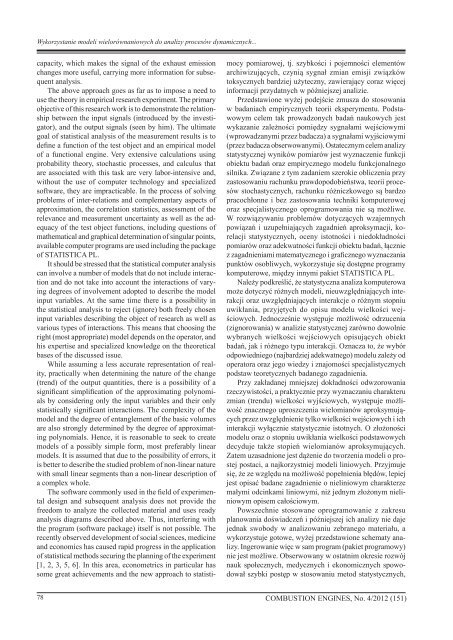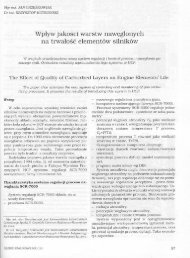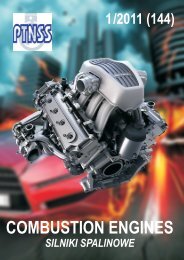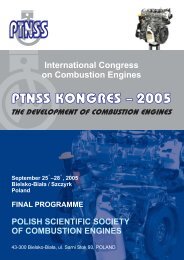You also want an ePaper? Increase the reach of your titles
YUMPU automatically turns print PDFs into web optimized ePapers that Google loves.
Wykorzystanie modeli wielorównaniowych do analizy procesów dynamicznych...<br />
capacity, which makes the signal of the exhaust emission<br />
changes more useful, carrying more information for subsequent<br />
analysis.<br />
The above approach goes as far as to impose a need to<br />
use the theory in empirical research experiment. The primary<br />
objective of this research work is to demonstrate the relationship<br />
between the input signals (introduced by the investigator),<br />
and the output signals (seen by him). The ultimate<br />
goal of statistical analysis of the measurement results is to<br />
define a function of the test object and an empirical model<br />
of a functional engine. Very extensive calculations using<br />
probability theory, stochastic processes, and calculus that<br />
are associated with this task are very labor-intensive and,<br />
without the use of computer technology and specialized<br />
software, they are impracticable. In the process of solving<br />
problems of inter-relations and complementary aspects of<br />
approximation, the correlation statistics, assessment of the<br />
relevance and measurement uncertainty as well as the adequacy<br />
of the test object functions, including questions of<br />
mathematical and graphical determination of singular points,<br />
available computer programs are used including the package<br />
of STATISTICA PL.<br />
It should be stressed that the statistical computer analysis<br />
can involve a number of models that do not include interaction<br />
and do not take into account the interactions of varying<br />
degrees of involvement adopted to describe the model<br />
input variables. At the same time there is a possibility in<br />
the statistical analysis to reject (ignore) both freely chosen<br />
input variables describing the object of research as well as<br />
various types of interactions. This means that choosing the<br />
right (most appropriate) model depends on the operator, and<br />
his expertise and specialized knowledge on the theoretical<br />
bases of the discussed issue.<br />
While assuming a less accurate representation of reality,<br />
practically when determining the nature of the change<br />
(trend) of the output quantities, there is a possibility of a<br />
significant simplification of the approximating polynomials<br />
by considering only the input variables and their only<br />
statistically significant interactions. The complexity of the<br />
model and the degree of entanglement of the basic volumes<br />
are also strongly determined by the degree of approximating<br />
polynomials. Hence, it is reasonable to seek to create<br />
models of a possibly simple form, most preferably linear<br />
models. It is assumed that due to the possibility of errors, it<br />
is better to describe the studied problem of non-linear nature<br />
with small linear segments than a non-linear description of<br />
a complex whole.<br />
The software commonly used in the field of experimental<br />
design and subsequent analysis does not provide the<br />
freedom to analyze the collected material and uses ready<br />
analysis diagrams described above. Thus, interfering with<br />
the program (software package) itself is not possible. The<br />
recently observed development of social sciences, medicine<br />
and economics has caused rapid progress in the application<br />
of statistical methods securing the planning of the experiment<br />
[1, 2, 3, 5, 6]. In this area, econometrics in particular has<br />
some great achievements and the new approach to statistimocy<br />
pomiarowej, tj. szybkości i pojemności elementów<br />
archiwizujących, czynią sygnał zmian emisji związków<br />
toksycznych bardziej użyteczny, zawierający coraz więcej<br />
informacji przydatnych w późniejszej analizie.<br />
Przedstawione wyżej podejście zmusza do stosowania<br />
w badaniach empirycznych teorii eksperymentu. Podstawowym<br />
celem tak prowadzonych badań naukowych jest<br />
wykazanie zależności pomiędzy sygnałami wejściowymi<br />
(wprowadzanymi przez badacza) a sygnałami wyjściowymi<br />
(przez badacza obserwowanymi). Ostatecznym celem analizy<br />
statystycznej wyników pomiarów jest wyznaczenie funkcji<br />
obiektu badań oraz empirycznego modelu funkcjonalnego<br />
silnika. Związane z tym zadaniem szerokie obliczenia przy<br />
zastosowaniu rachunku prawdopodobieństwa, teorii procesów<br />
stochastycznych, rachunku różniczkowego są bardzo<br />
pracochłonne i bez zastosowania techniki komputerowej<br />
oraz specjalistycznego oprogramowania nie są możliwe.<br />
W rozwiązywaniu problemów dotyczących wzajemnych<br />
powiązań i uzupełniających zagadnień aproksymacji, korelacji<br />
statystycznych, oceny istotności i niedokładności<br />
pomiarów oraz adekwatności funkcji obiektu badań, łącznie<br />
z zagadnieniami matematycznego i graficznego wyznaczania<br />
punktów osobliwych, wykorzystuje się dostępne programy<br />
komputerowe, między innymi pakiet STATISTICA PL.<br />
Należy podkreślić, że statystyczna analiza komputerowa<br />
może dotyczyć różnych modeli, nieuwzględniających interakcji<br />
oraz uwzględniających interakcje o różnym stopniu<br />
uwikłania, przyjętych do opisu modelu wielkości wejściowych.<br />
Jednocześnie występuje możliwość odrzucenia<br />
(zignorowania) w analizie statystycznej zarówno dowolnie<br />
wybranych wielkości wejściowych opisujących obiekt<br />
badań, jak i różnego typu interakcji. Oznacza to, że wybór<br />
odpowiedniego (najbardziej adekwatnego) modelu zależy od<br />
operatora oraz jego wiedzy i znajomości specjalistycznych<br />
podstaw teoretycznych badanego zagadnienia.<br />
Przy zakładanej mniejszej dokładności odwzorowania<br />
rzeczywistości, a praktycznie przy wyznaczaniu charakteru<br />
zmian (trendu) wielkości wyjściowych, występuje możliwość<br />
znacznego uproszczenia wielomianów aproksymujących<br />
przez uwzględnienie tylko wielkości wejściowych i ich<br />
interakcji wyłącznie statystycznie istotnych. O złożoności<br />
modelu oraz o stopniu uwikłania wielkości podstawowych<br />
decyduje także stopień wielomianów aproksymujących.<br />
Zatem uzasadnione jest dążenie do tworzenia modeli o prostej<br />
postaci, a najkorzystniej modeli liniowych. Przyjmuje<br />
się, że ze względu na możliwość popełnienia błędów, lepiej<br />
jest opisać badane zagadnienie o nieliniowym charakterze<br />
małymi odcinkami liniowymi, niż jednym złożonym nieliniowym<br />
opisem całościowym.<br />
Powszechnie stosowane oprogramowanie z zakresu<br />
planowania doświadczeń i późniejszej ich analizy nie daje<br />
jednak swobody w analizowaniu zebranego materiału, a<br />
wykorzystuje gotowe, wyżej przedstawione schematy analizy.<br />
Ingerowanie więc w sam program (pakiet programowy)<br />
nie jest możliwe. Obserwowany w ostatnim okresie rozwój<br />
nauk społecznych, medycznych i ekonomicznych spowodował<br />
szybki postęp w stosowaniu metod statystycznych,<br />
78 <strong>COMBUSTION</strong> <strong>ENGINES</strong>, No. 4/2012 (151)












